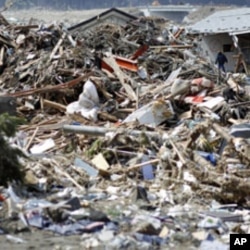It's been a week since a massive earthquake and tsunami devastated a large part of eastern Japan killing at least 6,548 people. While much of the attention remains focused on the crippled Fukushima number one nuclear plant, Japan's government has also begun looking at what comes next.
At 2:46 p.m. March 18, the disaster-hit north of Japan paused. Survivors bowed their heads and rescue work stopped for just one minute.
Japan marked the one-week anniversary of the combined earthquake and tsunami disaster with a grim statistic: the death toll passed that of 1995's earthquake in Kobe and it's likely to keep rising with more than 9,000 unaccounted for.
Many displaced
The disaster displaced some 380,000 people, who are currently living in over 2,000 shelters.
Friday Yoshihiro Murai, the governor of hard-hit Miyagi prefecture, suggested they might move to other parts of Japan.
Murai says there are 220,000 people homeless in his prefecture, and the local government will not be able to provide temporary housing for them any time soon. He says he will ask survivors to consider moving so they can enjoy better living conditions.
Aid continues to roll into the area, but damage to infrastructure is making distribution difficult. Life remains tough for the displaced, with complaints about shortages of food, water and gasoline.
But, day by day, more roads are being reopened allowing trucks of relief goods to reach most victims. However, some communities remain cut off.
Reassurance
On Friday evening, Japanese Prime Minister Naoto Kan spoke of the hardships in an address to the nation.
Kan said he understands people in shelters are cold and don't have enough food, but the government is doing all it can. He said he hopes to return a sense of security to them soon.















